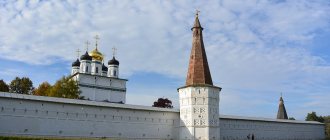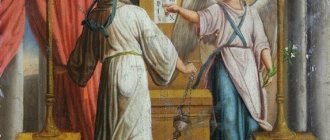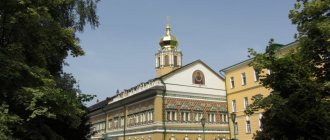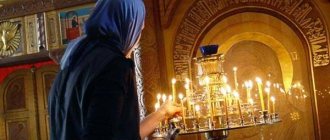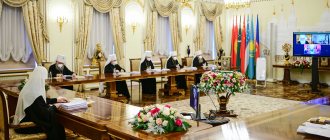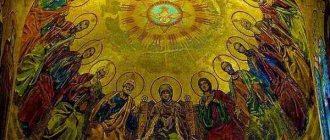| Grand Duchess Elizaveta Feodorovna |
Elisaveta Feodorovna
(1864 - 1918), Grand Duchess, Venerable Martyr Memory July 5, September 28 - the discovery of relics in 1918 [1], January 17 - the memory of the transfer of relics to Jerusalem in 1921 (ROCOR [2]), January 25 (Grech . [3]), in the Councils of Ekaterinburg, Moscow and St. Petersburg saints and in the Council of New Martyrs and Confessors of the Russian Church
Born on October 20, 1864 in the Protestant family of the Grand Duke of Hesse-Darmstadt Ludwig IV and Princess Alice, daughter of Queen Victoria of England. Ella was the second child in the family. The children were brought up in the traditions of old England. Their life passed according to the rules strictly established by their mother. Children's clothing and food were very basic. The three eldest daughters did the housework themselves: they cleaned the rooms, beds, and lit the fireplace. Subsequently, Elisaveta Feodorovna said: “They taught me everything in the house.”
In 1884, she married Grand Duke Sergei Alexandrovich, brother of Emperor Alexander III of Russia.
Seeing the deep faith of her husband, the princess with all her heart sought the answer to the question - which religion is true? She prayed fervently and asked the Lord to reveal His will to her. On April 13, 1891, on Lazarus Saturday, the rite of acceptance into the Orthodox Church was performed over Elisaveta Feodorovna. In the same year, Grand Duke Sergei Alexandrovich was appointed Governor-General of Moscow.
Visiting churches, hospitals, orphanages, nursing homes and prisons, the princess saw a lot of suffering. And everywhere she tried to do something to alleviate them. After the start of the Russian-Japanese War in 1904, Elisaveta Feodorovna helped the front and Russian soldiers in many ways. She worked until she was completely exhausted.
| Grand Duchess Elizaveta Feodorovna and Grand Duke Sergei Alexandrovich |
On February 4, 1905, Prince Sergei Alexandrovich died from a bomb explosion by a revolutionary terrorist.
Elisaveta Feodorovna rushed to the scene of the explosion and saw a picture that surpassed human imagination in its horror. Silently, without screaming or tears, kneeling in the snow, she began to collect and place on a stretcher the body parts of her beloved husband, who had been alive just a few minutes ago. In the hour of difficult trials, Elisaveta Feodorovna asked for help and consolation from God. The next day she received Holy Communion in the church of the Chudov Monastery, where her husband’s coffin stood. On the third day after the death of her husband, Elisaveta Feodorovna went to prison to see the killer. She didn't hate him. The Grand Duchess wanted him to repent of his terrible crime and pray to the Lord for forgiveness. She even submitted a petition to the Emperor to pardon the killer.
Elisaveta Feodorovna decided to devote her life to the Lord through serving people and create a monastery of work, mercy and prayer in Moscow. She bought a plot of land with four houses and a large garden on Bolshaya Ordynka Street. In the monastery, which was named Marfo-Mariinskaya in honor of the holy sisters Martha and Mary, two churches were created - Marfo-Mariinsky and Pokrovsky, a hospital, which was later considered the best in Moscow, and a pharmacy where medicines were dispensed to the poor for free, an orphanage and a school . Outside the walls of the monastery, a house-hospital was set up for women suffering from tuberculosis.
On February 10, 1909, the monastery began its activities. On April 9, 1910, during the all-night vigil, Bishop Trifon of Dmitrov (Turkestan) (+1934), according to the rite developed by the Holy Synod, consecrated the nuns to the title of sisters of the cross of love and mercy. The sisters took a vow, following the example of the nuns, to spend a virgin life in work and prayer. The next day, during the Divine Liturgy, Saint Vladimir, Metropolitan of Moscow and Kolomna, placed eight-pointed cypress crosses on the sisters, and elevated Elisaveta Feodorovna to the rank of abbess of the monastery. The princess said that day: “I am leaving the brilliant world ... but together with all of you I am ascending into a greater world - the world of the poor and suffering.”
| Grand Duchess Elizaveta Feodorovna |
At the Martha and Mary Convent, Princess Elisaveta Feodorovna led an ascetic life: she slept on a wooden bed without a mattress, often for no more than three hours;
she ate food very moderately and strictly observed fasts; at midnight she got up for prayer, and then went around all the hospital wards, often remaining at the bedside of a seriously ill patient until dawn. She told the sisters of the monastery: “Isn’t it scary that out of false humanity we are trying to lull such sufferers to sleep with the hope of their imaginary recovery. We would do them a better service if we prepared them in advance for the Christian transition into eternity.” Without the blessing of the monastery’s confessor, Archpriest Mitrofan of Srebryansky, and without the advice of the elders of Optina Hermitage and other monasteries, she did nothing. For complete obedience to the elder, she received inner consolation from God and gained peace in her soul. Since the beginning of the First World War, the princess organized assistance to the front. Under her leadership, ambulance trains were formed, warehouses for medicines and equipment were set up, and camp churches were sent to the front. The abdication of Emperor Nicholas II from the throne was a big blow for Elizabeth Feodorovna. Her soul was shocked, she could not speak without tears. Elisaveta Feodorovna saw into what abyss Russia was flying, and she wept bitterly for the Russian people, for her dear royal family.
Her letters from that time contain the following words:
“I felt such deep pity for Russia and its children, who currently do not know what they are doing. Isn't it a sick child whom we love a hundred times more during his illness than when he is cheerful and healthy? I would like to bear his suffering, to help him. Holy Russia cannot perish. But Great Russia, alas, no longer exists. We... must direct our thoughts to the Kingdom of Heaven... and say with humility: “Thy will be done.”
| Venerable Martyr Elisaveta Feodorovna, icon |
Elisaveta Feodorovna was arrested on the third day of Easter 1918, Bright Tuesday.
On that day, Saint Tikhon served a prayer service at the monastery. The monastery sisters Varvara (Yakovleva) and Ekaterina Yanysheva were allowed to go with her. They were brought to the Siberian city of Alapaevsk on May 20, 1918. Grand Duke Sergei Mikhailovich and his secretary Feodor Mikhailovich Remez, Grand Dukes John, Konstantin and Igor Konstantinovich and Prince Vladimir Paley were also brought here. Elisaveta Feodorovna's companions were sent to Yekaterinburg and released there. But sister Varvara ensured that she was left with the Grand Duchess.
On July 18, 1918, the prisoners were taken at night in the direction of the village of Sinyachikha. Outside the city, in an abandoned mine, a bloody crime took place. With loud curses, beating the martyrs with rifle butts, the executioners began to throw them into the mine. Princess Elizabeth was the first to be pushed down. She crossed herself and prayed loudly: “Lord, forgive them, they don’t know what they’re doing!”
Elisaveta Feodorovna and Prince John fell not to the bottom of the mine, but to a ledge located at a depth of 15 meters. Severely wounded, she tore off part of the cloth from her apostle and bandaged Prince John to ease his suffering. A peasant who happened to be near the mine heard the Cherubic Song sounding in the depths of the mine - the martyrs were singing.
| Killing prmts. Elizabeth and those with her. 6th mark of the icon of the Council of New Martyrs and Confessors of Russia from the Cathedral of Christ the Savior. |
Reverence
A few months later, the army of Admiral Alexander Vasilyevich Kolchak occupied Yekaterinburg, and the bodies of the martyrs were removed from the mine. The venerable martyrs Elizabeth and Varvara and Grand Duke John had their fingers folded for the sign of the cross. During the retreat of the White Army, the coffins with the relics of the holy martyrs were delivered to Jerusalem in 1920.
At the Council of Bishops on November 14, 1981, the Russian Orthodox Church Outside of Russia glorified the holy Grand Duchess as a venerable martyr among the holy new martyrs of Russia [4]. In the modern official calendar of the ROCOR, on July 5, the memory of “Reverend” is listed: led. Princess Elizabeth, nun Varvara and others like them. princes: John, Igor, Constantine, Sergius, Vladimir and martyrs. Theodora" [5]. All named persons are also included in the calendar of the Constantinople Orthodox Church [6].
On May 1 and 2, 1982, on the feast of the Holy Myrrh-Bearing Women, the relics of the Venerable Martyrs Elizabeth Feodorovna and Barbara were transferred from the crypt in the Church of Equal-to-the-Apostles Mary Magdalene at the foot of the Mount of Olives. At the beginning of the 21st century, the relics of the saints rest in this temple; two white marble tombs with icons of saints are located near the altar.
In the spring of 1992, Grand Duchess Elisaveta Feodorovna and nun Varvara were also glorified by the Council of Bishops of the Moscow Patriarchate. In 1995, at the site of the death of the holy martyrs, the Alapaevsky Monastery was founded in the name of the Russian New Martyrs.
On the icon of the Council of New Martyrs and Confessors, painted on the occasion of their common glorification in 2000, the sixth mark depicts the murder of the Venerable Martyr Elizabeth and others like her - her cell attendant Varvara, Grand Duke Sergei Mikhailovich, Prince Vladimir Paley, Grand Dukes John, Constantine and Igor, as well as their devoted servants.
Elisaveta Feodorovna
E.F. was actively involved in works of mercy. She was the chairman of the Petrovsky Charitable Society in St. Petersburg, the Shelter for Weak and Convalescent Children, the Tsarskoye Selo Charitable Society, and the First St. Petersburg Ladies' Committee of the Russian Red Cross Society. In 1896, she founded the Elisabeth community of sisters of mercy in St. Petersburg, which she regularly visited, despite moving to Moscow, and was present at the consecration of the community buildings and the temple in the name of the Great Martyr. Panteleimon, worked with board reports.
The grand ducal couple paid attention to the celebration of the Great Martyr's Day in Moscow. George, especially celebrated the Knights of St. George on this day. E.F. was the chief of the 51st Chernigov Dragoon Regiment. She participated in charity bazaars and in organizing Moscow flower festivals (the first one took place on May 20, 1901). The proceeds from these events went to charitable causes. E.F. was the chairman of the society for helping victims of the flood of 1908.
Vel. Kng. Elisaveta Feodorovna. Portrait. 1901 Artist. V. K. Shtemberg (Tretyakov Gallery) Vel. Kng. Elisaveta Feodorovna. Portrait. 1901 Artist. V. K. Shtemberg (Tretyakov Gallery)
E.F. plays an important role in the development of museums, art, and music. and theatrical unions. She participated in the preparatory committee of the X Archaeological Congress, in the organization of excavations on the territory of the Moscow Kremlin, in the acquisition and donation of various exhibits (ancient coins, crosses, icons, ancient weapons) to the Historical Museum, and contributed to the opening of the Catherine, Vladimir, Suzdal and other halls of the museum. E.F. loved church singing and especially appreciated the Synodal Choir, caring about the preservation and development of the muses. and theatrical culture. For a number of years she was a trustee of the Philharmonic Society. With her participation, a shelter for elderly theater workers was created, congresses of the Theater Society and benefit performances of outstanding actors were prepared, etc. E. F. helped the Stroganov and Synodal schools, courses for nurses of the community of the Iveron Icon of the Mother of God.
The opening and consecration (January 18, 1904) of the Shelaputin craft schools took place with the support of E.F. January 17. In 1892, the Charter of the Elisabeth Society for providing assistance to children of poor parents was approved, and B. A. Neidgart was appointed its chairman. Children of low-income parents, orphans, who not only lived and were raised, but also received vocational education at the expense of the society, entered the nurseries, kindergartens, and orphanages of the society. Over 25 years of work, the society has opened dozens of orphanages in parishes of churches in Moscow and its districts and provided assistance to 9 thousand children. Having asked for a blessing from the Moscow Metropolitan. Leonty (Lebedinsky), E.F. divided the city into 11 deaneries, in which, in turn, more than 200 Elizabethan committees were formed. E.F. placed dean fathers at the head of the groups. Nurseries and shelters were created at each parish in the capital. Over the course of 20 years, the Elisabeth Charitable Society opened 36 institutions for the care of children. To reward those who have selflessly fulfilled their duty for a number of years, the Regulations on the badge of the Elizabethan Charitable Society were adopted, approved on May 2, 1900. The right to wear the badge of the 1st, 2nd and 3rd degree was certified by a diploma signed by E. F. The highest form of reward for the society was the inscription of the names of its members on marble plaques erected on the wall of the meeting room of the Council of the society.
The Society for the Care of Poor and Needy Children was created earlier than the Elisabeth Charitable Society, but work was suspended for several years due to financial reasons. years. The goal of the society was to teach a profession, regardless of social origin and age. In 1893, as a result of a petition from the meeting of trustees to the sovereign, E.F. took the society under his patronage. In 1895, thanks to significant donations from E.F., construction began on a house for the 1st shelter of the society. The protection of the rights of children who were subjected to torture in various craft institutions, the consideration of complaints about ill-treatment of them prompted the creation of a special Committee of the Society, headed by P. N. Obninsky.
E.F. was the honorary chairman of the Ladies' Prison Committee, which looked after children whose mothers were serving sentences. Sewing workshops were organized for women released from custody, where they received a salary and could provide clothing for themselves and their children. The Ladies' Committee organized a shelter for women released from prison. Since 1893, charitable activities in prisons have been marked with a sign in the form of a blue enamel cross, which was inserted into a metal circle with the inscription: “Correct through philanthropy.” In 1898, the Ladies Prison Committee created a school for prison matrons in an effort to introduce a culture of communication into the daily life of prisoners.
In the days of Russian-Japanese. During the war, E.F. began work to provide comprehensive assistance to the army: she opened a donation warehouse to help the wounded and those in need, and organized free accommodation for the sick and wounded returning from the war. The commission for the deployment of soldiers was part of the Special Committee of Her Imp. Highness's leader. Kng. Elisaveta Feodorovna (February 12, 1904 - September 1, 1907), who opened his lips. and district institutions of 807 hospitals throughout Russia (with the exception of St. Petersburg province and Finland) and provided assistance to 25,535 lower ranks and 1,350 officers. Gr. A. A. Olsoufieff recalled that “the Grand Duchess was completely absorbed in this work... she thought about everything that could help the health and well-being of the soldiers...” (Olsoufieff. 1922. P. 4). In the Kremlin Palace, E.F. organized the work of women. “It was a whole ministry... divided into 12 departments, each with its own functions and tasks in providing assistance to the front” (Ibid. P. 4-5). The main directions of this work: supplying warehouses of Her Imp. Highnesses in Liaoyang, Mukden (Shenyang), Harbin and Red Cross warehouses in Nikolsk (now Ussuriysk) and Chita with necessary items and medical supplies; equipment and maintenance of 9 flying sanitary detachments; supplying the necessary equipment and things to floating hospitals; equipping 4 stage hospitals for 200 people; equipment and maintenance of a detachment to combat infectious diseases, etc. Reports on the sending of donations to the front were published in the Weekly and various newspapers. E.F. was especially concerned about “helping the Russian people with their spiritual needs... by sending many camp churches equipped with everything necessary for worship” (Ibid. P. 4). Oct 25 In 1908, in the Moscow All Saints Grove, the Sergius-Elisabeth shelter for crippled soldiers, where they could learn crafts, was consecrated.
Vel. Kng. prmts. Elisaveta Feodorovna. Portrait. 1917 Artist. I. M. Mitrofanov (State Literary Museum of I. S. Turgenev, Orel)
Vel. Kng. prmts. Elisaveta Feodorovna. Portrait. 1917 Artist. I. M. Mitrofanov (State Literary Museum of I. S. Turgenev, Orel)
During the revolution of 1905, a decision was made to move the grand ducal family to the Kremlin. 4 Feb from an explosion carried out by terrorist I.P. Kalyaev on Senate Square. in the Kremlin, the leader died. book Sergey Aleksandrovich. This day was the last for E.F. in her social life. 7 Feb. E.F. went to the prison where Kalyaev was kept, left him the Gospel and an icon, after which she turned to Nicholas II with a petition to pardon Kalyaev, but the petition was rejected. At the site of her husband’s murder, E.F. erected a monument-cross, made according to the design of V.M. Vasnetsov. The words of the Savior spoken by Him on the cross were inscribed on the monument: “Father, let them go, for they do not know what they are doing” (cf. Lk 23.34). On the initiative of E.F., to preserve the memory of her husband P.V. Zhukovsky in Chudovoy in honor of the Miracle of the arch. Mikhail in Khoneh husband. mon-re in the Kremlin under the supervision of academician. R.I. Klein's temple-tomb was created. book Sergei Alexandrovich.
The Moscow December armed uprising of 1905 (on the occasion of the sovereign’s name day, E.F. was in St. Petersburg these days) gave E.F. the occasion to write that “the revolution cannot end from day to day, it can will only worsen or become chronic, which, in all likelihood, will happen. “My duty,” noted E.F., “is now to help the unfortunate victims of the uprising. I simply consider myself vile, staying here, I prefer to be killed by the first random shot from some window than to sit here with folded arms... You shouldn’t be afraid of death, you should be afraid of living” (Dzhunkovsky. 1997. P. 135).
E.F. chose a special form of asceticism - charity. She invested her capital in establishing a monastery of mercy. In 1907, she and Bud. the confessor of the monastery, Rev. Mitrofan (later Rev. Sergius (Srebryansky)) began to create a charter for the new monastery of sisters of mercy. In May of the same year, E.F. bought an estate with a large garden on Bolshaya Ordynka, where in October. opened an infirmary for the wounded. 20 Nov next year Moscow Metropolitan. sschmch. Vladimir (Epiphany) approved the Charter of the monastery, the purpose of which is “through the work of the sisters of the monastery of mercy and in other possible ways to help in the spirit of pure Christianity the sick and poor and to provide help and comfort to the suffering and those in grief and sorrow.”
10 Feb 1909 The Marfo-Mariinskaya Moscow convent officially began its activities. 9 Sep. of the same year, Bishop of Dmitrov. Tryphon (Turkestan) consecrated the 1st temple of the monastery - in the name of Saints Martha and Mary, the so-called. sick leave Apr 9 1910 in this church bishop. Tryphon ordained 17 sisters of the monastery, led by E.F., to the rank of cross, who took vows of obedience, non-covetousness and chastity without monastic tonsure and promised to do good deeds in the spirit of Christ. love, caring for the poor and sick. 10 Apr 1910 Moscow Metropolitan. Vladimir E.F. was confirmed in the position of abbess. The sisters were spiritually nurtured by Archpriest. Mitrofan Srebryansky and St. Alexy (Soloviev), mon. Zosimova is empty. Orthodox Christians could become sisters. widows and girls aged 21 to 40 years. They were divided into crusaders (more experienced) and students. All sisters, after undergoing appropriate training at the monastery, were required to visit the poor and provide assistance to them. The monastery taught nurses free of charge, gave out medicines, carried out electrotherapy, gave massages, injections, and operated on; the library was open; a shelter for orphans, a Sunday school, and a canteen for the poor were created, in which over 300 lunches were prepared daily.
In addition to the indispensable participation in divine services, twice a week the confessor of the monastery held conversations of a catechetical and patristic nature with the sisters. Akathists were read in the monastery church 4 times a week. Upon initiation, the sisters received a cypress cross on a white ribbon (with the image of the Savior Not Made by Hands and the Protection of the Blessed Virgin Mary; on the reverse side there are images of the holy wives Martha and Mary) and a rosary. Every day everyone had to say 100 Jesus prayers. The interior of the monastery was dominated by white color; light-colored chintz was used for decoration. The sisters wore light long dresses specially made for them and white apostolics, reminiscent of the robe of St. Elizabeth of Thuringia. In 1911, E.F. submitted a petition to the Holy Synod to confer the title of deaconesses on the elder sisters of the Martha and Mary Convent. The resolution of the issue was postponed until the Local Council of the Russian Orthodox Church.
In 1908-1912 The Intercession Church of the monastery was built in the Novgorod-Pskov style of the 16th century. according to the project of architect. A. V. Shchusev and painted by the artist. M. V. Nesterov. P. D. Korin painted the underground temple-tomb. 8 Apr. In 1912, the consecration of the Metropolitan Church took place. Vladimir, bishop Trifon and Bishop of Serpukhov. Anastasy (Gribanovsky). The activities of the Martha and Mary Convent were aimed at supporting the poor, sick and suffering. The sisters served in the free institutions of the monastery: a hospital, an outpatient clinic, a pharmacy, an orphanage, a Sunday school, a library, a canteen for the poor, and a home for consumptive women on Donskaya Street. At the monastery, the sick also received spiritual help: unction, conversations, prayers, daily services for the sick in the center. Saints Martha and Mary. Since the autumn of 1913, the sisters provided medical assistance to the inhabitants of the Khitrov Market shelters, and homeless children were transferred to shelters.
Simultaneously with the creation of the Marfo-Mariinsky monastery in Moscow, under the leadership. E.F. in Sergievsky Posad in 1910-1911. The Mariinsky Shelter (shelter) was built and opened for elderly nurses of the Red Cross, who followed. disability or age required care. A house temple was built in the shelter in the name of Equal Apostles. Mary Magdalene, whose rector E.F. appointed priest. Pavel Florensky (see: Andronik (Trubachev), abbot. The sacrament of the priesthood in the fate of Father Pavel Florensky // Now and forever: Russian magazine for reading. 2006. No. 3-4).
An outpatient clinic was established in the shelter. led book Sergei Alexandrovich, the region served the poor population of Sergievsky Posad. During the war of 1914-1918. the shelter accepted wounded soldiers for treatment, despite their age, they were cared for by elderly nurses.
Vel. Kng. Elisaveta Feodorovna. Portrait. Beginning XX century Artist F. A. von Kaulbach (GMZ “Pavlovsk”)
Vel. Kng. Elisaveta Feodorovna. Portrait. Beginning XX century Artist F. A. von Kaulbach (GMZ “Pavlovsk”)
E.F. slept on a wooden bed without a mattress, with a hard pillow, 2-3 hours a day, prayed in church at midnight, and visited the sick in the infirmary. E. F. devoted her time free from charitable work to pilgrimage trips. She repeatedly visited the Trinity-Sergius, Kiev-Pechersk and Pochaev Lavra, Optina Monastery, Savvin Storozhevsky Monastery, Tikhonova Monastery, Solovetsky, Sarov, New Jerusalem Monastery, Sergius Monastery, Zosimova Monastery, monasteries located near S. -Petersburg, as well as other ancient mon-ri. E.F. participated in holidays glorifying God’s saints, such as St. Seraphim, abbot. Sarovsky, sschmch. Ermogen, and in the celebrations associated with the secondary acquisition of the relics of the king. blgv. Anna Kashinskaya. In a letter to Nicholas II, E.F. called the days spent in 1909 in Kashin “an ideal repetition of Sarov” (GARF. F. 601. Op. 1. D. 1254). E.F. comprehended the meaning of “spiritual teaching” through pilgrimage and in the process of reading hagiography and patristic literature, as well as in conversations with the schema-archim. Gabriel (Zyryanov), priests Alexy and German Zosimovsky, schema abbot. Spanish Tamar (Mardzhanova), Optina elders hieromonks Reverend Nektarios (Tikhonov) and Anatoly (Potapov).
E. F.’s pilgrimage to the mon-ri of the Urals was interrupted by the First World War. In Moscow, E.F. organized a Committee to provide charitable assistance to the families of persons called up for war. A hospital was opened at the Marfo-Mariinsky Convent. During the war days, E.F. headed dozens of institutions as a trustee or chairman. On July 29, 1914, at a committee meeting held in the house of E. F. in the Martha and Mary Convent, it was decided to open a permanent coordinating body (committee office) and to begin accepting monetary and clothing donations, as well as to establish the “Weekly” , in which all these issues will be covered. One of the main tasks of the committee was to provide work for the wives of soldiers called up for war. The houses of the Governor General, the Russian Noble Assembly and Starogostiny Dvor were given over to the workshops. The families of soldiers were also provided with agricultural assistance, and the children of those drafted to war were provided with everything they needed. 27 Sep. 1914 committee led. The princess decided to open a number of institutions for orphans. At the call of E.F., Russian actors and artists carried out charitable work in favor of soldiers and their families. A kind of help to the front was the publication of postcards and reproductions of paintings by great Russians. artists (for example, a reproduction of Nesterov’s painting “Mercy”) and E.F.’s drawings, calendars, etc. E.F. sent Russian soldiers. armies of several compositions with Christmas gifts. In 1914, the republished E.F. book went on sale. "Under a gracious sky"; the profits made from the sale of the book were donated to the children of the warriors. E.F. attracted outstanding artists to this publication: Nesterov, V.D. Polenov, N.K. Roerich, Korin and others.
E.F.’s committee collected funds to support homeless children in shelters and complete the construction of premises for children’s labor cooperatives. Committee funds raised from the moment of its creation until January 1. 1916, allowed to provide assistance to the families of 75 thousand conscripted soldiers, 45 thousand children of soldiers lived in shelters (including 30 thousand toddlers); 7.8 million meals were provided to those in dire need; 25 thousand people whose relatives were drafted into the active army were accommodated in free and cheap apartments and received benefits; More than 25 million items of uniform were manufactured for the needs of the army; approximately 89 thousand families of soldiers were provided with fuel free of charge or at a reduced price; received cash benefits approx. 341.5 thousand families; the total number of registered needy families of soldiers who received this or that assistance from E.F. institutions exceeds 895 thousand. The vast majority of the requests of those in need were satisfied. In 1914, E.F. began work on organizing the Fraternal Cemetery at the Church. All Saints in Vsekhsvyatskoe, on which the Church of the Transfiguration of the Lord was built according to the design of the architect. Shchuseva.
In June 1915, the Grand Duchess's committee decided to allocate 500 thousand rubles. to expand the Sergius-Elisabeth shelter for crippled soldiers, where wounded soldiers and children of dead soldiers studied shoemaking, tailoring, and bookbinding. E.F. was involved in preparing and sending marching churches to the front. In 1915-1917 Unfounded accusations against the imp. have become widespread in society. Alexandra Feodorovna and E.F. in espionage for Germany. E.F. in letters to the emperor. Nicholas II noted that G.E. Rasputin was “in spiritual delusion,” the relationship between E.F. and the imp. Alexandra Feodorovna's situation worsened sharply due to disagreements over Rasputin's assessment.
13 Apr 1916 Met. Macarius performed the Divine Liturgy in the Church of the Martha and Mary Convent and a thanksgiving prayer on the occasion of the 25th anniversary of E.F.’s joining the Orthodox Church. Churches. On this day, Rev. sschmch. John Vostorgov, addressing the believers gathered at the monastery, noted that he led a life. The princess testifies to the truth of her faith. “In such Christianization,” said Fr. John, - when “life is true,” and spiritual progress occurs... Orthodoxy cannot now be taken from it even at the cost of martyrdom...” (Moscow. TsVed. 1916. No. 17. P. 226-230).
After the February Revolution, private charity was stopped. On March 10, 1917, an order was issued by the Commissioner of the Provisional Government of Moscow on the appointment of V.N. Grigoriev as a commissioner of all institutions that were under the jurisdiction of E.F. On March 24, E.F. resigned from her duties as chairman of the Committee for the provision of charitable assistance to the families of persons called up to war.
Aug 26 In 1917, a temple was consecrated in the Martha and Mary Convent in honor of the Ethereal Powers and all the saints. 21 Nov E.F. was present in the Assumption Cathedral of the Moscow Kremlin at the enthronement of His Holiness the Patriarch of Moscow and All Russia, St. Tikhon (Bellavina) (see: Urusova N.V. Maternal Lament of Holy Rus'. M., 2006. P. 112). 24 Jan 1918 E.F. ordered Korin to paint the image of the prophet. Elijah (in the collection of I. S. Ostroukhov). Perhaps this was the last order of E.F.
I. K. Kuchmaeva, L. B. Maksimova
Prayers
Troparion of the Prmc. led book Elizabeth, voice 1
By humility you hid your princely dignity, / the godly Elisaveto, / through the deep service of Martha and Mary, / you honored Christ. / By mercy, patience and love, you chose to honor yourself, / like a sacrifice you have offered yourself to God as a righteous woman, / but we, who honor your virtuous life and suffering, / as We earnestly ask you to be a true mentor:/ Holy Martyr Grand Duchess Elizabeth, // pray to Christ God to save and enlighten our souls.
Kontakion prmts. led book Elizabeth, voice 2
Who tells the story of the greatness of the feat of faith: / in the depths of the earth, as in heaven of lordship, / the passion-bearer Grand Duchess Elizabeth / with the angels rejoicing in psalms and songs / and enduring murder ,/ crying out for the godless tormentors:/ Lord, forgive them this sin,/ They don’t know what they are doing./ Through your prayers, O Christ God, // have mercy and save our souls.
